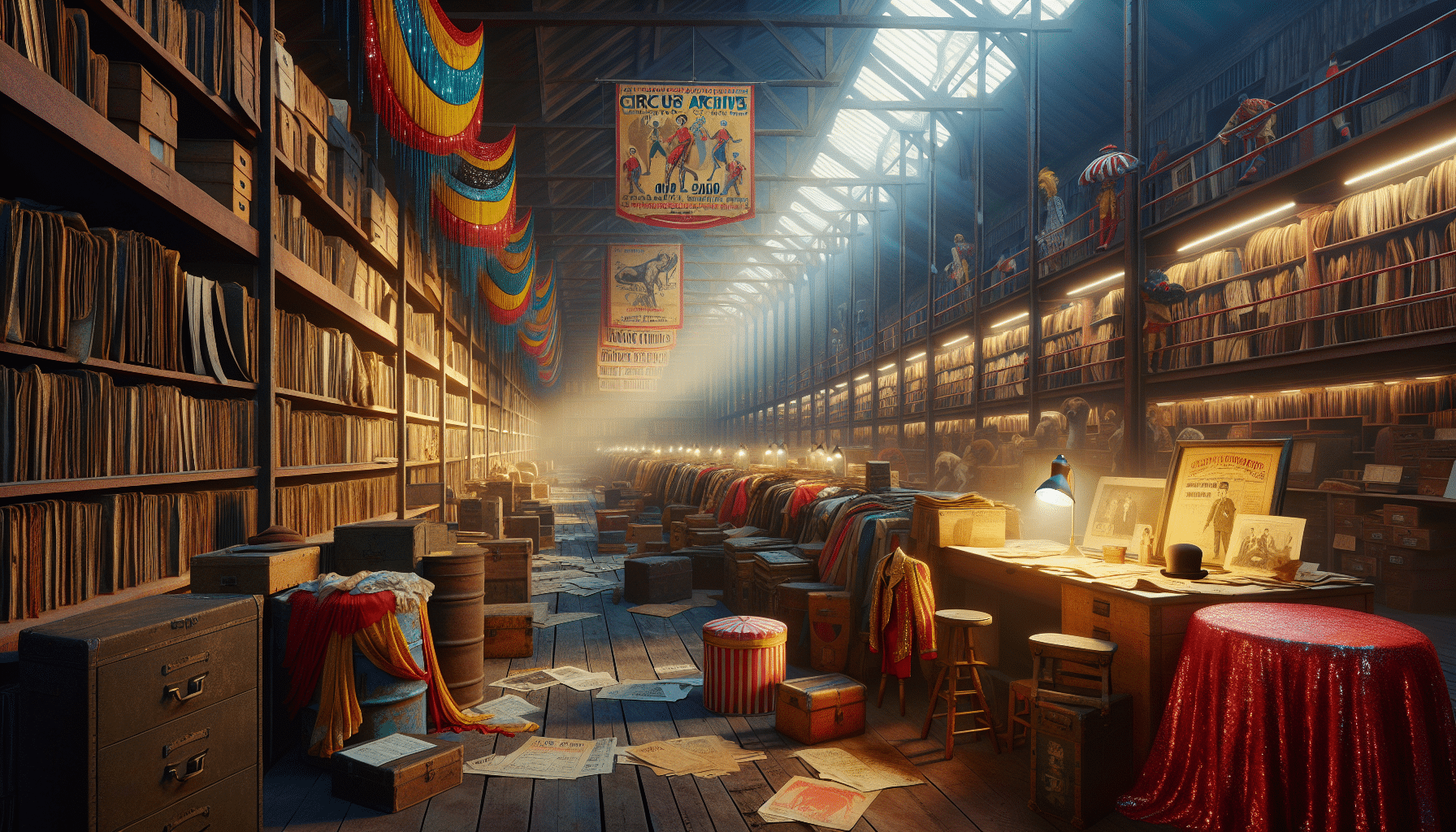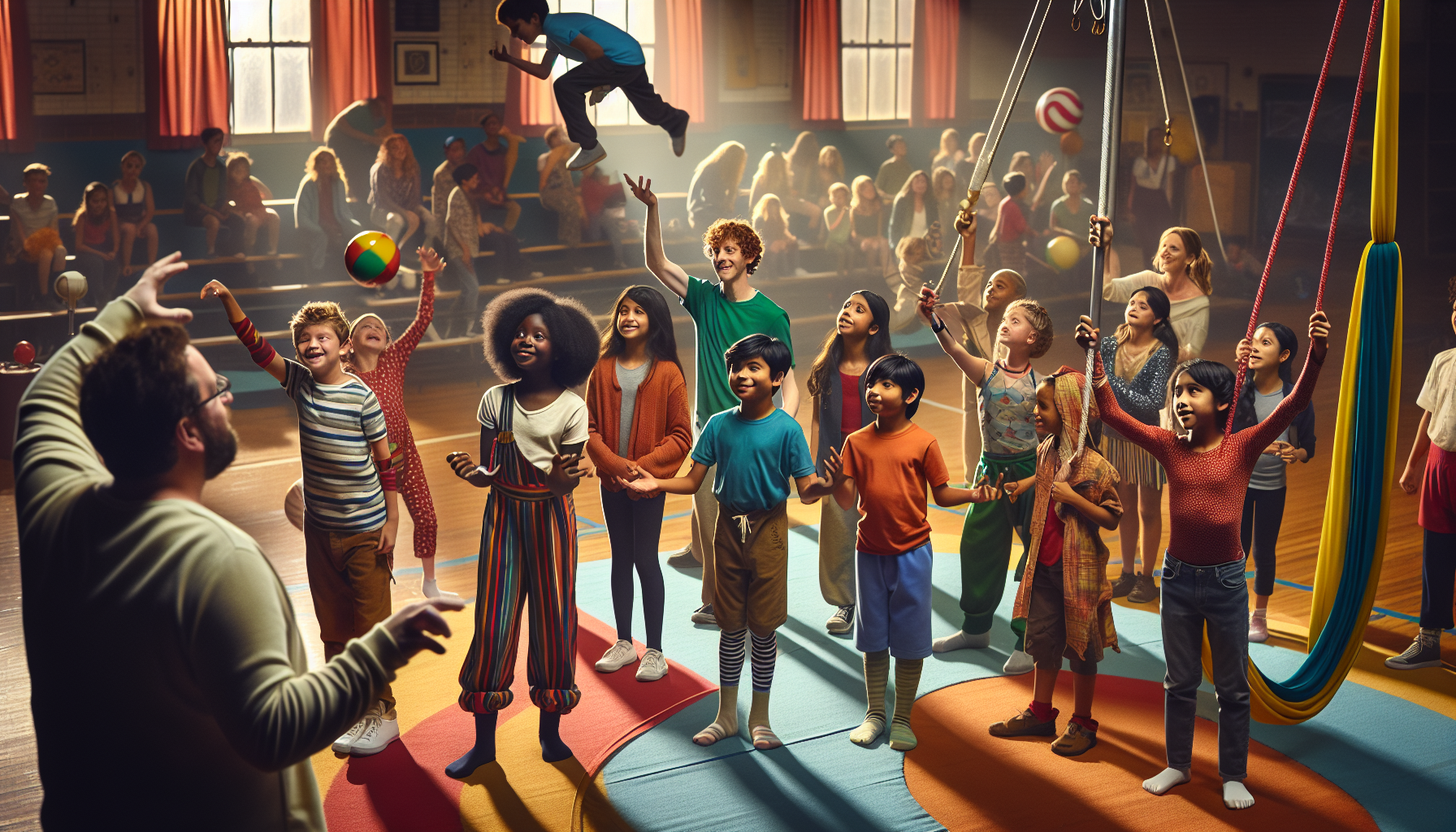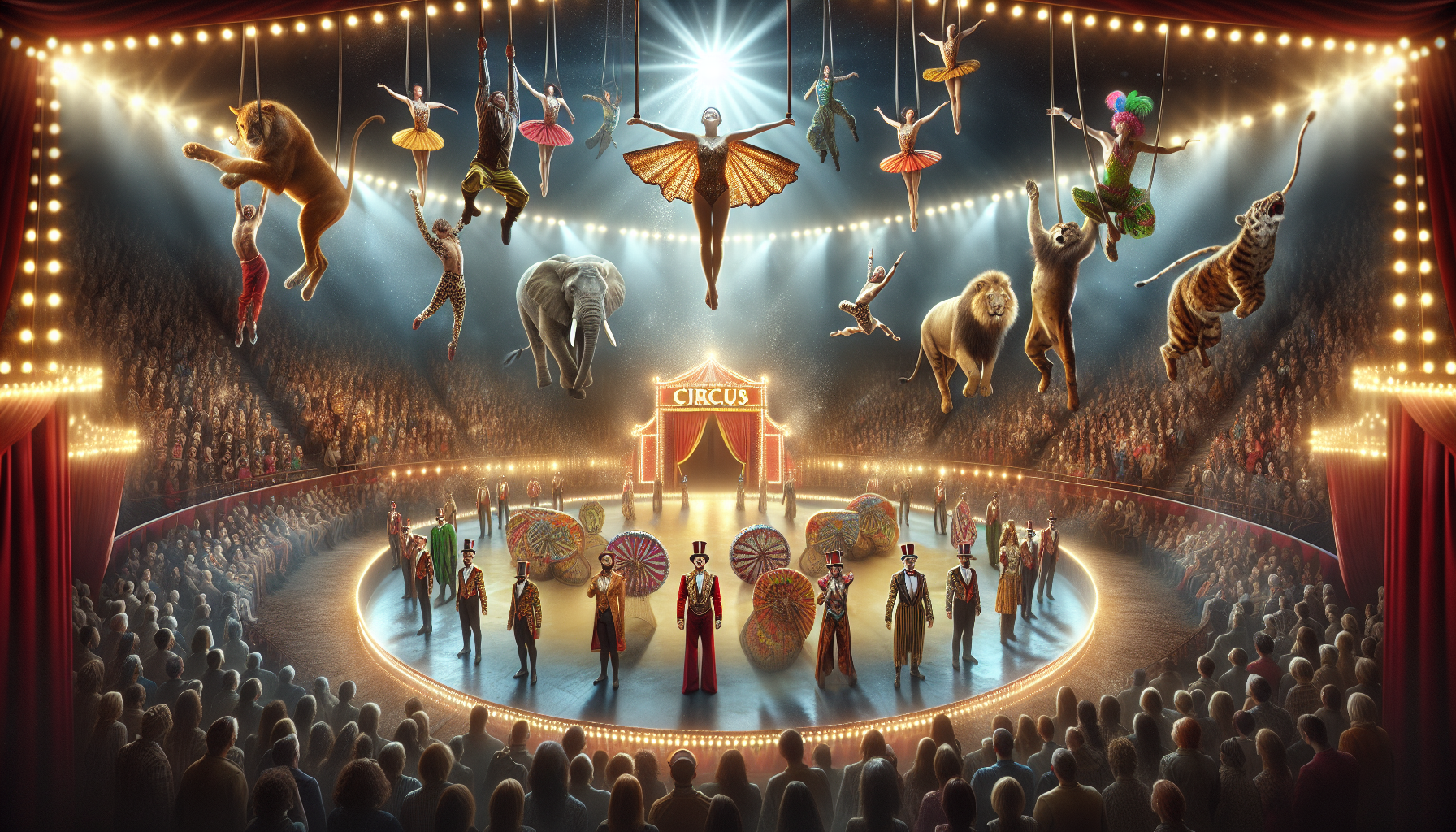🎪 Step right up and immerse yourself in a journey through time, as we unravel the mesmerizing history of circus archives, a treasure trove that preserves the enchanting legacy of what has long been celebrated as the “Greatest Show on Earth.” From the raucous applause of eager audiences to the behind-the-scenes orchestrations that brought wonder and excitement to countless hearts, the circus has etched itself into the cultural fabric of societies worldwide. This article invites you to delve deep into the world of circus archives, where stories of daring acrobats, majestic animals, and visionary showmen come alive, offering a vivid tapestry of human creativity and resilience.
The circus, with its dazzling blend of spectacle and skill, has always been more than just a form of entertainment. It represents a microcosm of the world, a place where boundaries are pushed, and the extraordinary becomes reality. Yet, as time marches on, preserving this vibrant legacy becomes a crucial task. Circus archives serve as the guardians of this rich heritage, capturing not just the performances but the spirit and evolution of this beloved art form. These archives are not merely collections of photographs, posters, and programs; they are the custodians of stories that bridge generations and cultures. By preserving these memories, archives ensure that the magic of the circus continues to inspire and captivate future audiences.
In this exploration, we will peel back the layers of circus history, beginning with its ancient roots and following its evolution through the centuries. We’ll trace its journey from the Roman arenas, where the seeds of spectacle were first sown, to the traveling circuses of the 19th century that crisscrossed continents, bringing joy and wonder to every corner of the globe. The archives reveal the transition from small, nomadic troupes to the grand circus extravaganzas that became cultural landmarks in cities around the world. We’ll examine how these archives illuminate the lives of the performers—the acrobats, clowns, and animal trainers—whose artistry and dedication defined an era.
Furthermore, this article will delve into the role of technology and innovation in the circus’s enduring allure. As we explore the archives, we’ll uncover how advancements in transportation, lighting, and special effects transformed the circus from a humble gathering into a spectacle of grand proportions. The archives offer insights into the challenges faced by circuses over the years, from logistical hurdles to societal changes, and how they adapted to remain relevant and engaging. We’ll discuss the impact of cinema and digital media on the circus’s popularity, and how archives help us understand the circus’s evolving relationship with its audience in an ever-changing world.
Finally, we’ll reflect on the importance of preserving circus archives in today’s digital age. With the rise of virtual reality and online platforms, the way we experience entertainment is shifting dramatically. Yet, there is a timeless charm in the tactile nature of circus memorabilia—handwritten letters, vintage posters, and fragile costumes—that digital media cannot replicate. As we celebrate the legacy of the circus, we’ll explore how modern archivists are using digital tools to make these treasures accessible to a global audience, ensuring that the history of the circus is not only preserved but continues to inspire future generations. So, tighten your grip on the trapeze of curiosity, and let’s swing into the captivating world of circus archives! 🎭📜
The Origin of Circus: Tracing Back the History
The circus, a form of entertainment that has captivated audiences for centuries, finds its roots in ancient times. The earliest recorded circus performances can be traced back to the ancient Roman Empire, where chariot races, equestrian performances, and staged battles took place in the famed Circus Maximus. This massive arena could hold tens of thousands of spectators, eager to witness the grand spectacles that became synonymous with Roman culture. Over time, the concept of a circus evolved, influenced by various cultures and their unique forms of entertainment.
In the medieval period, traveling performers known as jongleurs entertained townsfolk with juggling, acrobatics, and storytelling. These early performers were often itinerant, moving from place to place, much like modern circus troupes. It was during the 18th century in England that the modern circus began to take shape. Philip Astley, a former cavalry officer, is often credited as the father of the modern circus. In 1768, Astley opened the first circus in London, featuring equestrian acts performed in a circular arena, which enhanced the audience’s view and engagement. This format set the stage for the circus as we know it today.
As the circus gained popularity, it expanded beyond Europe. By the 19th century, the circus had become a global phenomenon, with troupes traveling across continents to perform. The introduction of the “big top” tent allowed circuses to bring their shows to various locations, further increasing their reach and accessibility. This period also saw the emergence of iconic acts, such as clowns, trapeze artists, and animal performances, which became staples of the circus repertoire. The circus was not just a form of entertainment; it was a reflection of societal changes, capturing the imaginations of people from all walks of life.
The Evolution of Circus Acts and Performers
Throughout history, circus acts have continually evolved, showcasing a blend of traditional and innovative performances. The allure of the circus lies in its ability to adapt and introduce new elements that captivate audiences. Early circus acts primarily focused on equestrian skills, but as the circus grew, so did the variety of performances. By the 19th century, acts such as trapeze artists, acrobats, and clowns became integral parts of the circus experience. These performers brought a new level of excitement and danger, captivating audiences with their daring feats and comedic antics.
The introduction of animal acts in circuses also played a significant role in their evolution. Exotic animals, such as elephants, lions, and tigers, were introduced to captivate audiences with their grandeur and rarity. These performances required skilled trainers and handlers, who worked tirelessly to ensure the safety and well-being of both the animals and the performers. However, in recent years, there has been a shift away from animal performances due to growing concerns about animal welfare. Many circuses have adapted by focusing on human talent and creativity, showcasing acts that highlight the skill and artistry of their performers.
Contemporary circuses, such as Cirque du Soleil, have redefined the concept of the circus, blending traditional acts with theatrical elements, music, and storytelling. These modern circuses prioritize the artistry and narrative of their performances, often featuring acrobatics, dance, and elaborate costumes and set designs. This evolution of circus acts reflects the changing tastes and values of audiences, while also preserving the legacy and wonder of the circus. 🎪
The Role of Circus Archives in Preserving History
Preserving the rich history of the circus is crucial to understanding its impact on culture and society. Circus archives play a vital role in documenting and preserving the legacy of this unique form of entertainment. These archives contain a wealth of information, including photographs, posters, costumes, and personal accounts from performers and audiences alike. By maintaining these records, circus archives help to ensure that future generations can appreciate and learn from the circus’s storied past.
Many institutions and organizations around the world are dedicated to preserving circus history. These archives serve as valuable resources for researchers, historians, and enthusiasts interested in exploring the cultural significance of the circus. For example, the Circus World Museum in Baraboo, Wisconsin, houses one of the largest collections of circus memorabilia in the world. The museum’s archives offer insight into the evolution of the circus, from its early beginnings to its modern incarnations. By preserving these artifacts, the museum helps to keep the spirit and history of the circus alive.
Digital technology has also played a significant role in preserving and sharing circus history. Many archives have digitized their collections, making them accessible to a global audience. Online platforms and social media allow circus enthusiasts to connect, share stories, and explore the rich tapestry of circus history. The accessibility of these digital archives ensures that the legacy of the circus can be celebrated and studied by people worldwide. 📜
Comparative Analysis: Traditional vs. Contemporary Circus
To understand the evolution of the circus, it is essential to compare traditional and contemporary circus forms. Traditional circuses, with their roots in the 18th and 19th centuries, focused on grand spectacles, often featuring animal acts, clowns, and acrobats. These circuses were characterized by their use of the big top tent, which allowed them to travel and perform in various locations. The traditional circus emphasized entertainment and spectacle, appealing to a broad audience with its diverse array of acts.
| Aspect | Traditional Circus | Contemporary Circus |
|---|---|---|
| Focus | Entertainment and spectacle | Artistry and narrative |
| Performances | Animal acts, clowns, acrobats | Acrobatics, dance, theatrical elements |
| Venue | Big top tent | Theaters and custom venues |
| Animal Welfare | Included animal acts | Focus on human performance, minimal animal acts |
Contemporary circuses, on the other hand, have shifted away from traditional elements, focusing more on artistry, storytelling, and the human element. These modern circuses often take place in theaters or custom venues, offering a more immersive and theatrical experience. The emphasis is on the skill and creativity of the performers, with acts that blend acrobatics, dance, and music to create a cohesive narrative. This shift reflects changing societal values, with a focus on creativity and innovation, while also addressing concerns about animal welfare.
Both traditional and contemporary circuses have their unique appeal, offering different experiences to audiences. While traditional circuses provide a nostalgic glimpse into the past, contemporary circuses push the boundaries of performance art, showcasing the limitless potential of human creativity. By understanding these differences, we can appreciate the diverse and evolving nature of the circus as an art form. To see the evolution in action, watch this video on the transformation of circus arts by Cirque du Soleil.
Challenges and Future of Circus Archives
Despite the importance of preserving circus history, circus archives face several challenges. One of the primary concerns is the preservation of fragile materials, such as photographs, posters, and costumes, which can deteriorate over time. Environmental factors, such as humidity and temperature fluctuations, can also affect the longevity of these items. Archivists must employ specialized techniques to ensure the preservation of these materials, often requiring significant resources and expertise.
Another challenge is the accessibility and organization of circus archives. With vast collections of materials spanning centuries, organizing and cataloging these archives can be a daunting task. Digital technology offers solutions to these challenges, allowing for the digitization and online accessibility of circus archives. However, the process of digitization can be time-consuming and costly, requiring collaboration and support from institutions, researchers, and enthusiasts.
Looking to the future, circus archives have the potential to play an even more significant role in preserving and promoting the legacy of the circus. By embracing digital technology and fostering collaborations with global institutions, circus archives can continue to expand their reach and impact. These archives not only preserve the history of the circus but also inspire new generations to explore the art form and its cultural significance. As the circus continues to evolve, its archives serve as a testament to its enduring legacy and the wonder it has inspired throughout history.
- Explore circus history at the Circus World Museum
- Discover modern circus performances with Cirque du Soleil
- Engage with online circus communities to share stories and insights

Conclusion
Unveiling the fascinating history of circus archives has taken us on a captivating journey through the vibrant and eclectic world of the “Greatest Show on Earth.” This article has explored the intricate tapestry of the circus’s past, highlighting the importance of preserving its legacy through meticulous archiving and storytelling. By delving into the rich history of the circus, we’ve uncovered the cultural significance and social impact of this beloved form of entertainment, which has captivated audiences for centuries.
The history of the circus is a story of resilience, creativity, and innovation. From its humble beginnings in ancient Rome to the grand spectacles of the modern era, the circus has continually evolved, adapting to the changing tastes and expectations of its audiences. This adaptability is a testament to the ingenuity and artistry of circus performers and producers, who have consistently pushed the boundaries of what is possible in the pursuit of wonder and excitement.
Throughout this article, we’ve discussed the critical role that archives play in preserving the circus’s legacy. Circus archives serve as a treasure trove of information, offering insights into the lives of performers, the evolution of acts, and the cultural context in which these performances took place. These archives are invaluable resources for historians, researchers, and enthusiasts, providing a window into the past and ensuring that the stories of the circus are not lost to time.
One of the central themes of this article has been the need for greater awareness and appreciation of circus archives. By highlighting the efforts of dedicated archivists and historians, we’ve underscored the importance of preserving this unique cultural heritage. These individuals work tirelessly to collect, catalog, and conserve a vast array of materials, from photographs and posters to personal letters and business records. Their work ensures that future generations will have the opportunity to explore and learn from the rich history of the circus.
Moreover, we’ve discussed the role of technology in modernizing the preservation of circus archives. Digital archiving has opened up new possibilities for accessibility and engagement, allowing a global audience to explore circus history from the comfort of their own homes. Online platforms and digital collections have democratized access to these materials, fostering a greater appreciation for the artistry and innovation that define the circus.
The significance of circus history extends beyond the realm of entertainment. It reflects broader societal changes, offering insights into the cultural, economic, and political contexts of different eras. By studying the history of the circus, we gain a deeper understanding of the world around us and the ways in which art and performance can both reflect and shape societal norms and values.
As we conclude our exploration of circus archives, it is essential to recognize the ongoing efforts to preserve and promote this unique cultural heritage. Organizations, museums, and individuals around the world are working tirelessly to ensure that the legacy of the circus is not forgotten. Their dedication and passion are inspiring, reminding us of the power of storytelling and the importance of preserving our shared history.
We encourage you, our readers, to engage with this fascinating subject. Whether by visiting a circus museum, exploring online archives, or supporting organizations dedicated to the preservation of circus history, there are countless ways to get involved. By sharing what you’ve learned with others, you help to ensure that the legacy of the circus continues to inspire and captivate future generations.
In closing, the history of the circus is a testament to the enduring human spirit and our innate desire to entertain, inspire, and connect with one another. As we celebrate the legacy of the “Greatest Show on Earth,” let us remember the importance of preserving our cultural heritage and the stories that define us. We invite you to join us in this journey, to explore, to share, and to keep the magic of the circus alive for generations to come. 🎪✨
Toni Santos is a visual storyteller and archival artisan whose creative journey is steeped in the bold colors, dramatic typography, and mythic imagery of old circus posters. Through his artistic lens, Toni breathes new life into these once-lurid canvases of wonder, transforming them into tributes to a golden era of spectacle, showmanship, and cultural fantasy.
Fascinated by the visual language of vintage circuses — from roaring lions to gravity-defying acrobats, from hand-painted banners to gothic typefaces — Toni explores how these posters once captured the imagination of entire towns with nothing more than ink, illusion, and a promise of awe. Each composition he creates or studies is a dialogue with history, nostalgia, and the raw aesthetics of entertainment on the move.
With a background in handcrafted design and visual heritage, Toni blends artistic sensitivity with historical insight. His work traces the forgotten typographies, chromatic choices, and symbolic flair that defined circus marketing in the 19th and early 20th centuries — a time when posters were not just advertisements, but portable portals to dreamworlds.
As the creative force behind Vizovex, Toni curates collections, illustrations, and thoughtful narratives that reconnect modern audiences with the magic of old circus art — not just as ephemera, but as cultural memory etched in paper and pigment.
His work is a tribute to:
The flamboyant storytelling of early circus posters
The lost art of hand-lettered show promotion
The timeless charm of visual fantasy in public space
Whether you’re a vintage print enthusiast, a circus history lover, or a designer inspired by antique aesthetics, Toni invites you into a world where tigers leap through fire, strongmen pose in perfect symmetry, and every corner of the poster whispers: Step right up.





